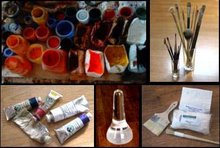Lefranc and Bourgeois 'Flemish' Mediums
As a gift, I received two glazing mediums by Lefranc and Bourgeois... tantalisingly entitled 'Flemish medium' and 'Flemish Siccative Medium'. Having tried out these mediums on my 'Still Life with Apples' painting, here are my early conclusions...
'Flemish siccative medium' - this comes in a bottle and is made up of copal gum, linseed oil and rectified turpentine. The colour is a rich amber, and the medium flows rather nicely out of the bottle. Generally, it was easy to use and does dries within a few hours. On first use, I applied it to the surface of an underpainting and also mixed a tiny amount in with my paint. The trouble came when it appeared to lift my underpainting in places, but I confess that my underpainting may not have been 100% bone dry at the time. I will certainly try this medium again.
'Flemish Medium' - this comes in a tubs and is made up of Gum mastic, linseed oil, essence of spike and cobalt-zirconium siccative. The colour is a mid-amber and the consistency is a very thick gel, verging on gluey. It came out of the tube reluctantly and then needed a fair amount of squishing with a palette knife before becoming malleable enough to paint with.
The Woes...
More than the 'siccative' medium, I found the Flemish Medium very difficult to get to grips with. At first I was just not sure what to do with it... it was so thick and sticky that it could not sensibly be mixed with paint. So I thought I would stick to my usual method of applying a thin layer to canvas and painting into it with neat paint. Well that was easier said that done... getting this stuff applied thinly to anything, by hand or brush, is a challenge.
Eventually I resorted to the palette knife in order to spread a thin layer of the medium, like marmalade, over the surface of the canvas. Then I used a stiff 'brights' brush to scrub it into the surface as thinly and evenly as possible, rubbing with the heel of my hand where necessary. This done, I then had exactly the same trouble with the paint... it was a lot like painting into superglue! Again, I reverted to a flat 'brights' brush to scumble paint into the surface.
The Pros...
Now the interesting thing is that although none of this sounds like much fun... the resulting paintwork actually looked rather good. So I persevered with several layers in this way, and gradually found ways to apply paint more softly, even with a sable brush, over the gluey surface. So... to summarise. Despite the problems I had getting to grips with this medium, there are several benefits to it.
- Firstly, the finished painting has a high gloss finish, that seems very resilient and won;t need varnishing.
- Secondly, the colours appear bright and pure.
- Thirdly, the paint layers all dried very fast - within 2 - 3 hours, so more than one layer can be achieved in a day.
I will certainly be trying out these mediums again. For more details:
- click on the link to step-by-step images underneath the Still Life with Apples painting.
- visit the Lefranc & Bourgeois mediums pages

No comments:
Post a Comment